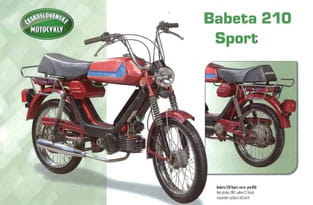
BABETTA Motorcycle PDF Manuals

History of Babetta Motorcycles
Above on the page there are several PDF Manuals & Electric Wiring Diagram for BABETTA Motorcycles.
Back in 1928, a Slovak engineer named Roth, owner of arms factories in Bratislava and Brno, opened another factory in the city of Povazska Bystrica.
In 1948, after the WW2, the plant received the name that it bears to this day "Povazske Strojarne".
The production of weapons was reduced, and the plant began to look for an alternative to its products, so a contract was signed with the JAWA plant for the joint production of motor vehicles.
The first result of the collaboration was the Manet 90 motorcycle, and at the end of 1955 the Pionier 50 scooter with a three-speed gearbox began to be produced, followed by the Pionier 550, 555, JAWA 20 and 21 also known as Mustang, and the Pionier 555 was licensed in India. and Egypt.
Production was not limited to the release of fifty kopecks and in 1956 the 100 and 125 cc Manet S-100 and Tatran 125 motorcycles were produced, which were exported to Hungary, Bulgaria, Romania and East Germany.
It is noteworthy that the name Manet comes from the name of the Manin mountains, which were visible from the window of the plant.
This name could also be seen on refrigerated trucks that were produced at the same time.
In the second half of the 60s, the Czechoslovak company Motokov, which exported JAWA and Povazske Strojarne products, looking at the success of Solex, decided to enter the market for light mopeds that do not require a driver's license.
However, this turned out to be a difficult task and Motokov refused to further work in this direction.
Despite this setback, Povazske Strojarne considered the new direction promising.
In 1970, the first batch of 100 motorbikes was produced, and in 1971, serial production began. A distinctive feature of these light mopeds was the electronic contactless ignition, hidden in a red box (Transimo), which was previously only used on cars.
By that time, cooperation with the JAWA plant had been discontinued and a new name was required for new products.
Despite the fact that Germany and the Netherlands do not buy Babetta anymore. the market is being filled with more modern mopeds and scooters, a new model of an engine with a kickstarter is being produced in Kolarovo and a barter agreement is concluded with the Riga plant for the supply of frames from the well-known Stella mokik.
In 1997, the gates of the plant were closed.
Thus ended Babetta's story.
However, mopeds with the name Babetta still roam the roads of Cuba, the USA, South America, Europe and China, those 43 countries of the world where Babetta was exported from a small town, where there is not even a hotel and there is only one restaurant.
